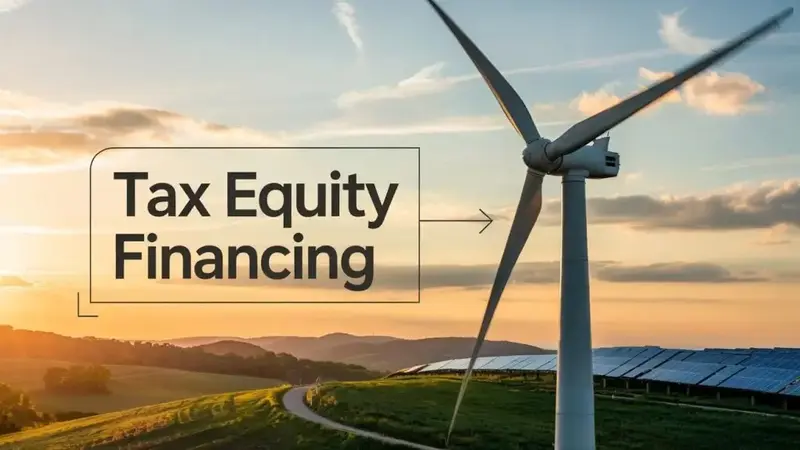Introduction to Tax Equity Financing
Tax equity financing stands as a cornerstone in propelling the clean energy revolution throughout the United States, fundamentally driving the deployment of renewables on a massive scale. At its core, this financial model allows major institutional investors—including influential banks and large Fortune 500 corporations—to inject capital into wind, solar, and emerging renewable projects. In return for their investment, these entities receive significant economic benefits through tax credits, which can be used to offset federal tax obligations.
This approach offers a powerful incentive for participation, particularly for those companies with substantial tax liabilities looking for innovative methods to bolster their bottom line while supporting sustainable development. More than just a funding tool, tax equity financing is tightly aligned with America’s broader environmental and economic goals, fueling efforts to achieve aggressive carbon reduction targets and accelerate the much-needed energy transition. For a more detailed exploration of the dynamic role financial institutions play in this field, you can consult an in-depth guide to renewable energy tax credits for banks and investors, revealing how evolving policy and market structures shape opportunities for all stakeholders. The influence of tax equity in advancing clean energy has never been more pronounced.
In recent years, the urgency of the climate crisis has catalyzed both public and private actors to seek mechanisms that accelerate project timelines and unlock financing for technologies at the heart of decarbonization efforts. Investors—from veteran energy financiers to newcomers seeking exposure to stable, government-supported returns—increasingly turn to tax equity transactions to diversify holdings and mitigate portfolio risk.
Mechanics of Tax Equity Financing
Tax equity financing structures begin at their foundation when a developer—often constrained by limited financial resources or the inability to absorb significant tax credits—seeks external capital to initiate a renewable energy development. These projects may range from expansive wind farms stretching across rural landscapes to strategically placed solar arrays that feed power into the grid. Despite their potential, many developers cannot fully leverage the substantial federal tax credits or benefits of accelerated depreciation due to their relatively modest tax profiles.
Tax equity investors step in: typically sophisticated banks or major corporations with consistent, predictable tax liabilities. These investors provide upfront capital—often hundreds of millions of dollars—to fund construction and operation. In return, they receive a negotiated share of the project’s tax benefits, including credits and depreciation deductions, for an agreed-upon period. The two most pivotal federal incentives driving these deals are the Investment Tax Credit (ITC), which usually covers about 30% of a clean energy project’s qualified costs, and the Production Tax Credit (PTC), delivered based on the volume of electricity generated.
This arrangement ensures developers access funds that might otherwise remain out of reach, while investors obtain an efficient pathway to offset tax expenses and earn steady, risk-mitigated returns. The intricate legal and accounting structures underlying these deals are meticulously crafted to comply with IRS guidelines, balancing economic rewards and risk appropriately. Tax equity financing has become the linchpin for scaling renewable assets nationwide.
Benefits and Challenges
Tax equity financing delivers many tangible benefits for each party in the clean energy ecosystem. For project developers, access to tax equity unlocks significant capital, enabling them to accelerate construction schedules, scale operations, and lower the overall cost of capital. Federal tax incentives become fully utilized, maximizing returns and supporting project feasibility even in challenging market environments. Tax equity offers investors a powerful and strategic tool, particularly banks and financial institutions with predictable, sizable tax liabilities. They obtain a method to reduce their tax burden efficiently and gain exposure to a government-supported asset class with stable, attractive, risk-adjusted returns. Tax equity helps investors meet financial and social goals. In today’s market, sustainability and ESG (Environmental, Social, and Governance) factors increasingly influence investment performance.
Despite these significant advantages, there are inherent challenges to successfully navigating tax equity’s complex terrain. The regulatory environment constantly evolves, often subject to abrupt shifts with changes in federal administration or IRS interpretations. Volatility in project development pipelines, fluctuations in electricity markets, uncertainty regarding the valuation of future tax credits, and variability in technology performance introduce elements of risk that require sophisticated assessment.
Future Outlook
Looking ahead, tax equity financing will continue to play a key role in driving U.S. clean energy growth and achieving climate and decarbonization goals. Demand for renewable energy continues to soar, and market innovations—such as the expanded transferability of credits, new project structuring techniques, and broader participation by non-traditional investors—are making this financial mechanism more accessible and dynamic than ever. As supportive policy frameworks and industry momentum converge, tax equity will likely become even more central in enabling the next wave of renewable energy investments, building on current successes to deliver a cleaner and more resilient energy landscape for future generations.
In this ever-evolving industry, staying informed and adaptable will be critical for all stakeholders. Banks, investors, and project developers must remain agile in the face of new incentives, regulatory guidance, and strategic opportunities to ensure they capture the full range of benefits offered by tax equity structures. Today’s groundbreaking transactions and transformative policy changes are setting a formidable precedent, shaping an investment environment in which clean energy projects of every size can succeed and thrive.
